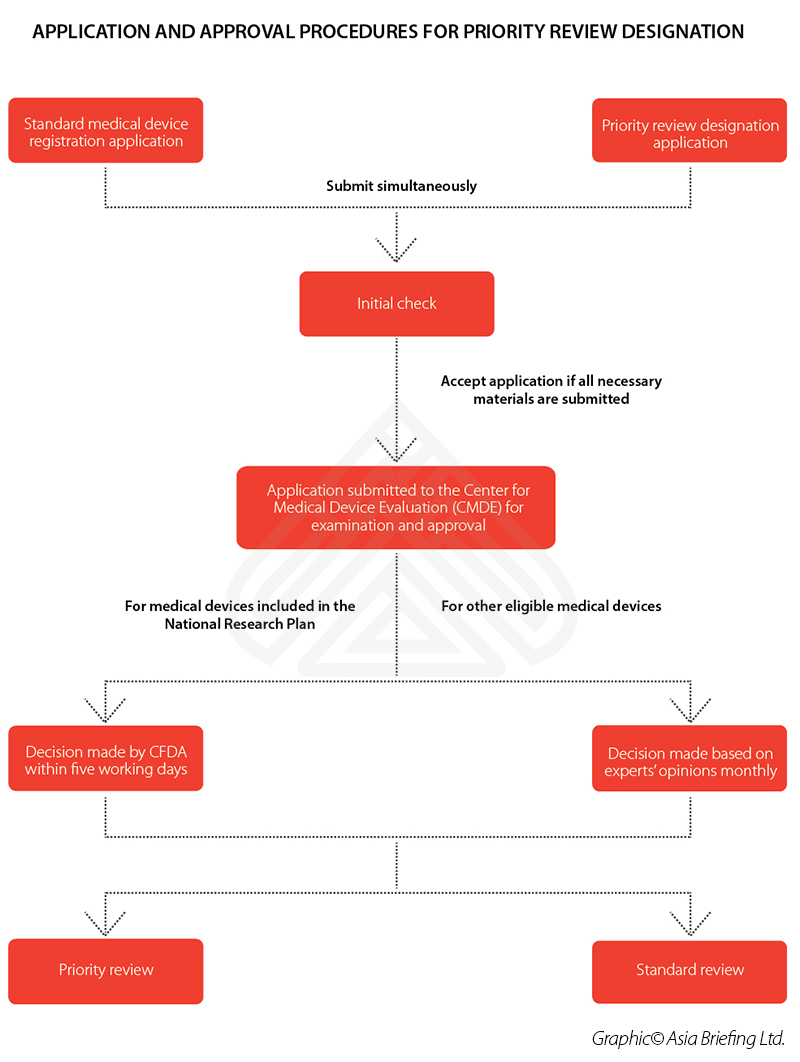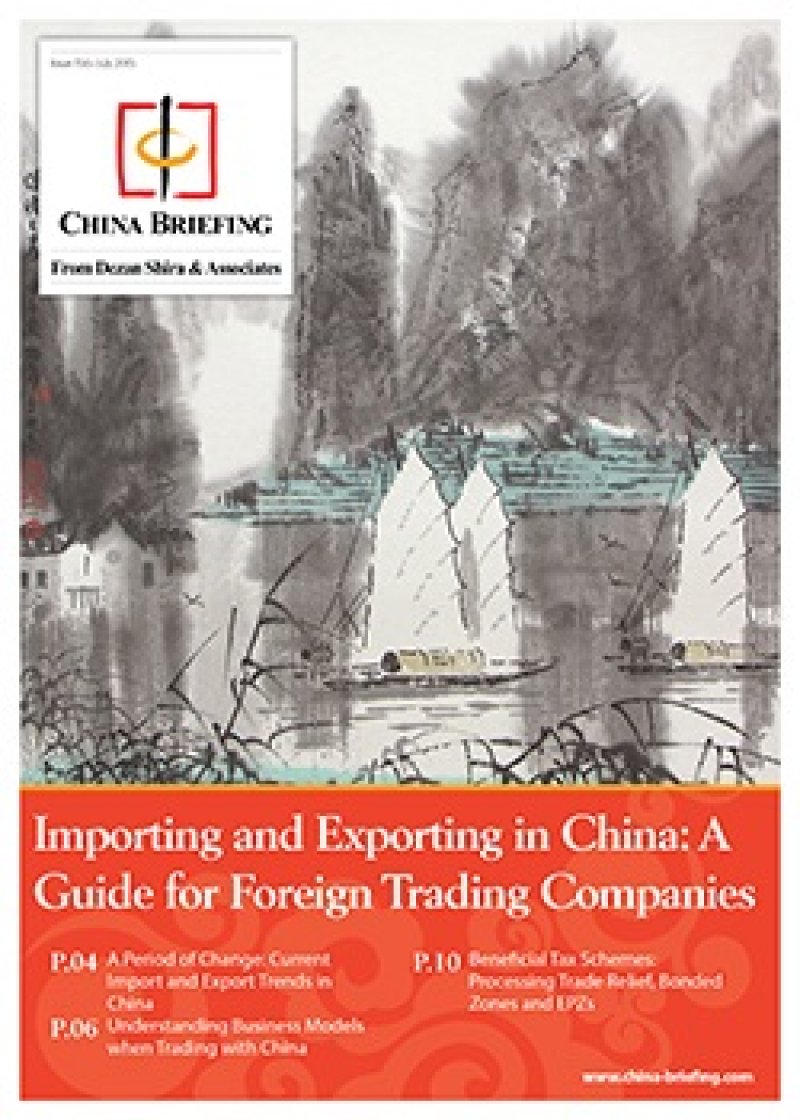Cutting Through the Red Tape: CFDA Plans to Accelerate the Review Process for Medical Devices
By Dezan Shira & Associates
Editor: Xiao Anna Wang
On June 20, 2016, the China Food and Drug Administration (“CFDA”) proposed the “Priority Review Designation Procedure for Medical Devices (Exposure Draft)”in an effort to cut through the persistent bureaucratic red tape in the registration process of medical devices and fulfill China’s rising clinical demand for medical devices.
The release of the Exposure Draft came after the State Council’s publishing of the “Opinions on the Reform of Review and Approval System for Drugs and Medical Devices” back in 2015, the focal point of which was the inefficiency of the medical device approval process. In response, the CFDA proposed a new approval mechanism – “Priority Review Designation Procedure” – and drafted the eligibilities, application and opposition procedures, as well as other requirements for joining the special treatment.
Priority Review Designation
According to the Exposure Draft, the Priority Review Designation Procedure is limited to medical devices categorized as domestic Class III, imported Class II, or imported Class III. China’s classification regime is based on the risk that a device presents to patients, with Class III reserved for the riskiest yet the most sophisticated devices, such as heart valve prosthesis. Therefore, medical devices categorized as Class III usually go through more costly and time-consuming examination procedures than other Classes.
![]() RELATED: Setting up a Dental Clinic in China
RELATED: Setting up a Dental Clinic in China
Exclusive to high-end medical devices, the Priority Review Designation Procedure also requires that these devices satisfy either one of the following conditions to be eligible for the Priority Review Designation:
(1) Have been enrolled in the National Science and Technology Major Project or National Key Research and Development Plan, or
(2) Meet any of the following conditions:
- Are able to diagnose or treat rare diseases, with outstanding clinical advantages;
- Are able to diagnose or treat malignant tumors, with outstanding clinical advantages;
- Are able to diagnose or treat specific and frequently occurring diseases in the elderly, and where there is no effective way to diagnose or treat such diseases at the moment;
- Are able to diagnose or treat specific and frequently occurring diseases in children, and where there is no effective way to diagnose or treat such diseases at the moment; and
- Are able to address an urgent clinical demand while similar medical devices have not been registered in China yet.
The CFDA will seek advice from professionals and grant priority review to other medical devices if necessary.
Overview of China’s Medical Devices Industry
The medical device market in China witnessed tremendous growth during the past decade. Sales of medical devices exceeded RMB 308 billion in 2015, up more than 50 percent compared to the previous year. A number of social-economic factors are and will continue to drive expansion of Chinese medical devices market, including:
- Aging society: According to the National Bureau of Statistics, China’s elderly population aged 60 and over reached 222 million in 2015, accounting for 1 percent of the country’s total population. The share of Chinese senior citizens is projected to further grow to 35 percent by the end of 2050, according to the World Health Organization. With this rapidly expanding aging population, the medical device industry in China is poised for a sustained period of rapid growth.
- Rising living standards: The per capita disposable income of Chinese urban residents has substantially increased from RMB 10,493 in 2005 to RMB 31,195 in 2015, according to the National Bureau of Statistics. The improvement in purchasing power has made health investment more affordable for almost every household in China, further spurring the demand for medical devices.
- Lopsided market structure:Compared to developed countries in which the public spending on medicines and medical devices is of roughly equal size, China favors medicine treatment over medical devices – the market for medical devices is only 14 percent of that for medicine, leaving a large part of the market underserved. If this dynamic changes, as many believes it will, the medical devices market will see another up-cycle.
Long Journey to Reform
Despite a myriad of opportunities attracting many medical device manufacturers and suppliers, the application for medicines medicine and medical devices stacks up on top of regulatory agents’ tables in the CFDA. In 2015, 21,000 applications were under examination, marking the third peak since 2005, according to CFDA officials. Some medical device companies denounce that the standard registration process can take up to seven to eight years under the current approval system, indicating that the review process essentially prevents them from entering the market.
China has come a long way in reducing the medical devices registration processing time, aiming to make more advanced technologies and devices accessible for the interest of public health.
Currently there are two fast-track review procedures in effect. Back to 2009, the CFDA enacted an expedited review process for medical devices applicable to emergency public health incidents. For instance, in an effort to test and prevent further dissemination of the Zika Virus that was found in China, the CFDA earlier this year granted an accelerated review process for the Zika Virus Test Kit, a technology developed by a domestic medical company called Tianlong. Another fast track approval process exists was designated for innovative medical devices which must be first of its kind functioning in China. Furthermore, the intellectual property of the medical device must be acquired within China.
![]() RELATED: Business Advisory Services from Dezan Shira & Associates
RELATED: Business Advisory Services from Dezan Shira & Associates
Moreover, the CFDA revised its “Regulations on the Supervision and Administration of Medical Devices”, the highest level regulations governing the registration, manufacture and distribution of medicines medicine and medical devices, and supervising all types of illegal market behaviors. The Regulations stipulate that manufacturers of Class I medical devices now only need to submit filings instead of registrations to the CFDA, which will potentially lead to a shorter wait time for approval. Furthermore, the CFDA plans to squeeze the initial review of Class II devices to 60 days and that of Class III devices to 90 days, but such timeframes seem unlikely when external expert reviews or combination device-medicine reviews are involved.
The Priority Review Designation Procedure will be the third streamlined review program once enacted. While this can be exciting news for medical device developers and manufacturers, there still remains some uncertainties in the Exposure Draft, such as how much time the Priority Review Designation Procedure can realistically reduce during the approval process. With the Exposure Draft already closed for public on the comment, the official rules from the CFDA are expected to be released soon.
Compared to many other industries, the medical devices industry is more sensitive to regulatory change, as alterations will have a direct impact on the time it takes to obtain relevant permits, and thus the companies’ market entry strategy. Medical device companies and any interested investors are therefore advised to keep abreast of the latest regulatory updates at all times through the CFDA website, or contact a professional directly at Dezan Shira & Associates.
|
Asia Briefing Ltd. is a subsidiary of Dezan Shira & Associates. Dezan Shira is a specialist foreign direct investment practice, providing corporate establishment, business advisory, tax advisory and compliance, accounting, payroll, due diligence and financial review services to multinationals investing in China, Hong Kong, India, Vietnam, Singapore and the rest of ASEAN. For further information, please email china@dezshira.com or visit www.dezshira.com. Stay up to date with the latest business and investment trends in Asia by subscribing to our complimentary update service featuring news, commentary and regulatory insight. |

 China Investment Roadmap: The Medical Device Industry
China Investment Roadmap: The Medical Device Industry
In this issue of China Briefing, we present a roadmap for investing in China’s medical device industry, from initial market research, to establishing a manufacturing or trading company in China, to obtaining the licenses needed to make or distribute your products. With our specialized knowledge and experience in the medical industry, Dezan Shira & Associates can help you to newly establish or grow your operations in China and beyond.
Importing and Exporting in China: a Guide for Trading Companies
In this issue of China Briefing, we discuss the latest import and export trends in China, and analyze the ways in which a foreign company in China can properly prepare for the import/export process. With import taxes and duties adding a significant cost burden, we explain how this system works in China, and highlight some of the tax incentives that the Chinese government has put in place to help stimulate trade.
 Establishing & Operating a Business in China 2016
Establishing & Operating a Business in China 2016
Establishing & Operating a Business in China 2016, produced in collaboration with the experts at Dezan Shira & Associates, explores the establishment procedures and related considerations of the Representative Office (RO), and two types of Limited Liability Companies: the Wholly Foreign-owned Enterprise (WFOE) and the Sino-foreign Joint Venture (JV). The guide also includes issues specific to Hong Kong and Singapore holding companies, and details how foreign investors can close a foreign-invested enterprise smoothly in China.
- Previous Article China’s Free Trade Zones Open Further to Foreign Investment
- Next Article City Spotlight: Investing in Dongguan






























